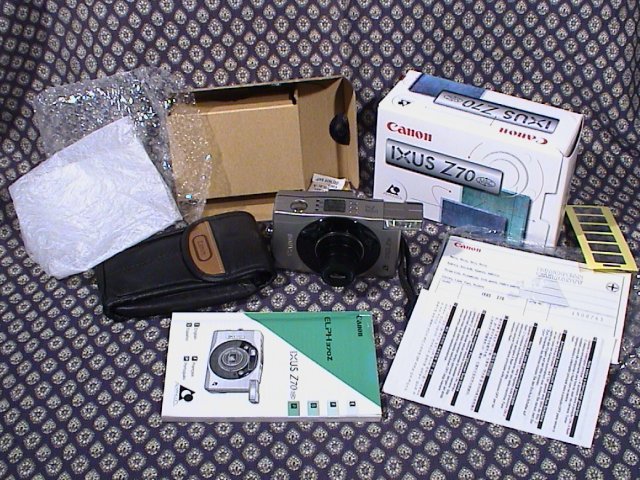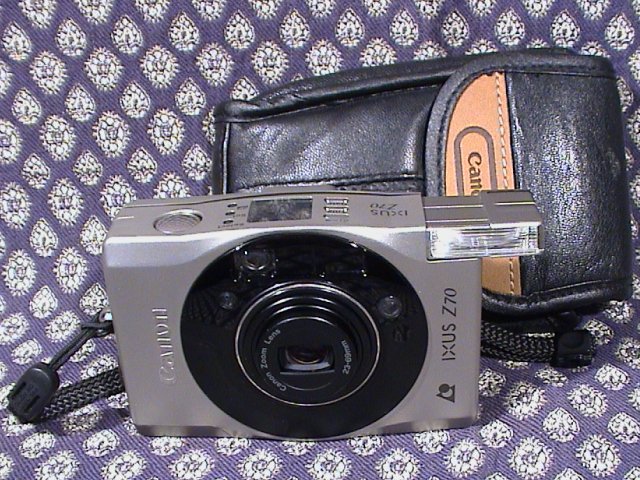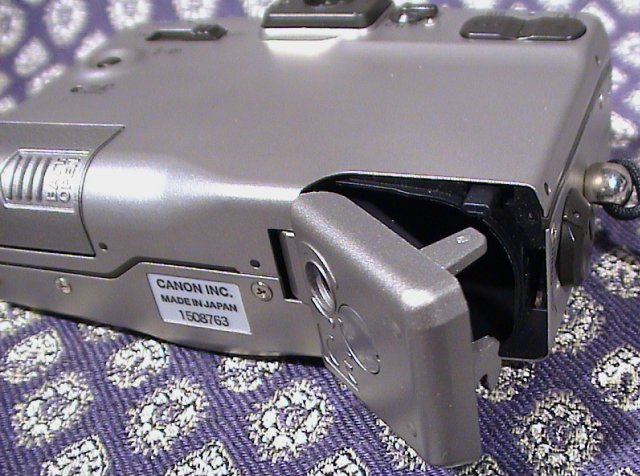introduction | IX240 | IX240 gold | 240 hard case | II | II photokit | II limited edition | III | III Photokit | Z50 | Z50 photokit | Z50 white box | Z65 | Z65 photokit | Z70 | Z90 | L1 | L1 black | L1 black photokit | M1 photokit | M1 white box | M1 tin can | M1 (Elph LT) Green | AF | AF-s | FF | Concept Arancia | Concept summer | X-1 | Compared

New price £259.99 2004/11
Ebay
2004/08/31 24GBP
2004/10/04 17.25GBP
2004/10/23 49.95USD
2004/10/24 35GBP
2004/10/25 20.99GBP
2004/11/19 18GBP
2004/11/20 40.50EUR (black presentation box)
2004/12/05 31.51GBP
2004/12/06 24.50GBP
2004/12/08 66.01USD
2005/03/11 61USD
2005/09/08 30.55EUR
3-69mm f4.5-9.9 lens. 2s-1/500s shutter. Autofocus. Landscape mode. Flash with red-eye reduction.

The Ixus Z70 is the bigger
brother of the original Ixus IX240. It is 99x65x38mm compared to the 90x60x28mm
of the Ixus IX240 and is 208g compared to the 166g original. As well as
the 'standard' APS features of drop-in film loading, three picture sizes, and
time/date/message printing, it also boasts mid-roll film changing and print
quantity encoding (which allows you to choose the number of copies of each
individual shot you want). On top of that, its zoom is 23-69mm rather than
24-48mm.
![]() On
the Ixus IX240 the power switch is mounted on the front of the camera, just
where the middle finger of your right hand naturally rests. On the Z70, it's a
slider on the back, just where your left thumb tends to end up.
On
the Ixus IX240 the power switch is mounted on the front of the camera, just
where the middle finger of your right hand naturally rests. On the Z70, it's a
slider on the back, just where your left thumb tends to end up.
The viewfinder, although small, is still easy to see through, and framing shots is a job of seconds - although the guidelines were slightly out of kilter with the edges of the viewfinder. Likewise, the camera fits easily into your hands, and all the buttons are placed logically, just where your fingers and thumbs naturally come to rest.
Despite its extra features and increased zoom range the Z70 just doesn't grab your attention like the original Ixus. Although it's only slightly larger, the size increase is just enough to slip it over the line between 'tiny' and 'merely small', partly due to the Z70's more rounded appearance. Likewise, whereas the power button on the Ixus not only opens and extends the lens, but also flips up the flash in a display of motorised sexiness, the slider switch on the Z70 manually pushes the flash out to the side in a far less groovy fashion.
It is a solid well designed APS camera, but lacks the appeal of smaller cameras like the Konica Revio and the original Ixus IX240. Although some might prefer the features for size there are more feature laden models available; notably Fuji's Fotonex 3500IX
The world's smallest 3x zoom AF
camera
Canon's new Advanced Photo System
compact camera features a 23-69mm 3x zoom lens, with a stylish look similar to
that of the original IXUS. Wrapped in a high quality stainless steel design,
this ultra compact camera includes drop-in loading, print aspect ratio control
C/H/P, mid-roll change and four flash over ride modes
|
|
||||||||||||||||||||||||||||||||||||||||||||||||||||||||||||||||||||||||||||||||||||||||||||||||||||||||||||||||||
|
||||||||||||||||||||||||||||||||||||||||||||||||||||||||||||||||||||||||||||||||||||||||||||||||||||||||||||||||||
![]()


Last Updated on 8th September 2005